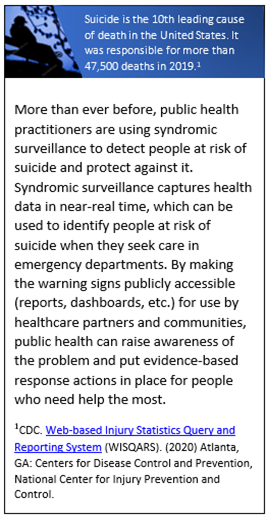State of Washington Uses Suicide-related Syndromic Surveillance to Guide Behavioral Health Response During COVID-19 Pandemic
The coronavirus disease 2019 (COVID-19) pandemic created a stressful and emotionally charged environment for many people. Managing stress was a challenge. Self-care and targeted interventions became essential for people in some occupations and social roles at greatest risk for behavioral problems, including suicide. Concerned with the suicide risk and mental health of at-risk populations in its communities, the state of Washington shared syndromic surveillance data to raise awareness of suicide risk and give behavioral experts data that could be used for prevention.

The Washington State Department of Health uses the Rapid Health Information NetwOrk (RHINO) to conduct syndromic surveillance on five behavioral health conditions that can be detected in emergency department settings: psychological distress, suicidal ideation, suspected suicide attempts, alcohol-related conditions, and suspected all-drug overdoses. Each week, the Washington State Department of Health disseminates surveillance reports based on deidentified patient records to the public through its website, provides them to state pandemic response leaders, and shares them with behavioral health system partners. In addition to sharing data from RHINO in the weekly reports, the department of health develops monthly forecasts and conducts population-level outreach in communities. For example, analysts in a local public health department grew concerned when syndromic data triggered alerts of a rise in suspected suicide attempts. They contacted the Washington State Department of Health, which then showed these data to leaders in local incident management. Washington state and its behavioral health partners and response teams developed a targeted public health response that included issuing provider alerts (e.g., suicide and overdose risk) and creating county-specific maps to guide local health jurisdictions’ response efforts.
Syndromic data are now an essential part of the state of Washington’s monthly behavioral health impact forecast used by health partners and state agencies for strategic planning and intervention. Syndromic data help public health get a head start on preparing for behavioral health impacts on mental health, such as suicide attempts. Through funding from the CDC’s National Syndromic Surveillance Program and the National Center for Injury Prevention and Control, syndromic surveillance is improving the nation’s public health.
Public Health Problem
Stress and anxiety during the coronavirus disease 2019 (COVID-19) pandemic are common. Isolation, unemployment, social distancing, worry about sending children to school, and frequent media coverage of the pandemic and related problems have contributed to growing mental and behavioral health problems. Managing such challenges can be stressful to those in some occupations and social roles, making self-care and public health interventions even more essential.
Concerned about mental health among Washingtonians, the Washington State Behavioral Health Strike Team (BHST), which leads and coordinates Washington’s behavioral health response to COVID-19, examined deidentified health record data captured by syndromic surveillance. They began sharing the warning signs of behavioral health and suicide risk with behavioral health specialists and partner agencies skilled in designing population-level interventions to prevent potential suicides.
Actions Taken
BHST uses the Rapid Health Information NetwOrk (RHINO) for surveillance and dissemination of emergency department data on suicidal ideation and suicide attempts. Syndromic data from RHINO are included in weekly situation reports that describe the potential statewide behavioral health effects of COVID-19. Pandemic response staff, behavioral health agencies, and other healthcare organizations rely on situational reports to inform planning and intervention efforts. BHST makes reports available to the public through the Washington State Department of Health website, provides them to state response leadership, and routinely shares them with behavioral health system partners. Deidentified data from syndromic surveillance are part of the monthly behavioral health impact forecast that health partners and state agencies use for population-level strategic planning and intervention.
Outcome
In addition to providing weekly reports and monthly forecasts, BHST conducts targeted outreach in communities to help populations at greatest risk. For example, analysts in a local public health department grew concerned when syndromic data triggered alerts for more emergency department visits than expected for monitored behavioral health conditions. They contacted BHST, which then elevated concerns to local incident management leadership. The analysts provided supportive syndromic data and offered to help tailor a targeted response.
Data from syndromic surveillance have enabled Washington behavioral health partners and response teams to respond quickly when they observe suicide-related outcomes of the COVID-19 pandemic. Recent examples of public health actions include issuing provider alerts on suicide and overdose risk, a youth-focused report on behavioral health, and creating county-specific maps to guide local health jurisdictions’ response efforts. Lessons learned from the COVID-19 response can also be used to prepare for the behavioral health impact of other emerging threats to public health. At the national level, BHST continues to coordinate closely with CDC on the topic of suicide risk and provides valuable input that is advancing the agency’s syndromic surveillance of nonfatal suicide-related outcomes.
What information is in the Behavioral Health Impact Situation Report?
An example is shown here. This report shows potential behavioral health impacts of the COVID-19 pandemic for Washington state and can be used to inform planning efforts. The report includes suicidal ideation and suspected suicide attempts, substance use (drug overdose and alcohol-related emergency visits), symptoms of anxiety and depression, care seeking behaviors, statistics on how services are being used, and more.
The latest COVID-19 updates for Washington State Department of Health can be accessed here along with healthcare provider resources and recommendations.
Contacts
Office of Public Health Data, Surveillance, and Technology
Division of Health Informatics and Surveillance
www.cdc.gov/nssp
This success story shows how NSSP
- Improves Data Representativeness
- Improves Data Quality, Timeliness, and Use
- Strengthens Syndromic Surveillance Practice
- Informs Public Health Action or Response
The findings and outcomes described in this syndromic success story are those of the authors and do not necessarily represent the official position of the National Syndromic Surveillance Program or the Centers for Disease Control and Prevention.

